Garlic, with its unmistakable aroma and rich, savory taste, is a beloved staple in kitchens around the world. For home cooks, its versatility and depth of flavor make it indispensable, whether used to create a subtle, fragrant base or a bold, punchy highlight in dishes. Beyond its role as a seasoning, roasted or sautéed garlic transforms into a sweet, mellow delight, bringing warmth and complexity to meals. Its robust character elevates everything from hearty stews to delicate pastas, making it not just an enhancer but a star ingredient that can stand deliciously on its own.
Here are some of our favorite garlic cooking and serving ideas:
Favorite garlic recipes
Oyster Mushroom Sautéed in Garlic
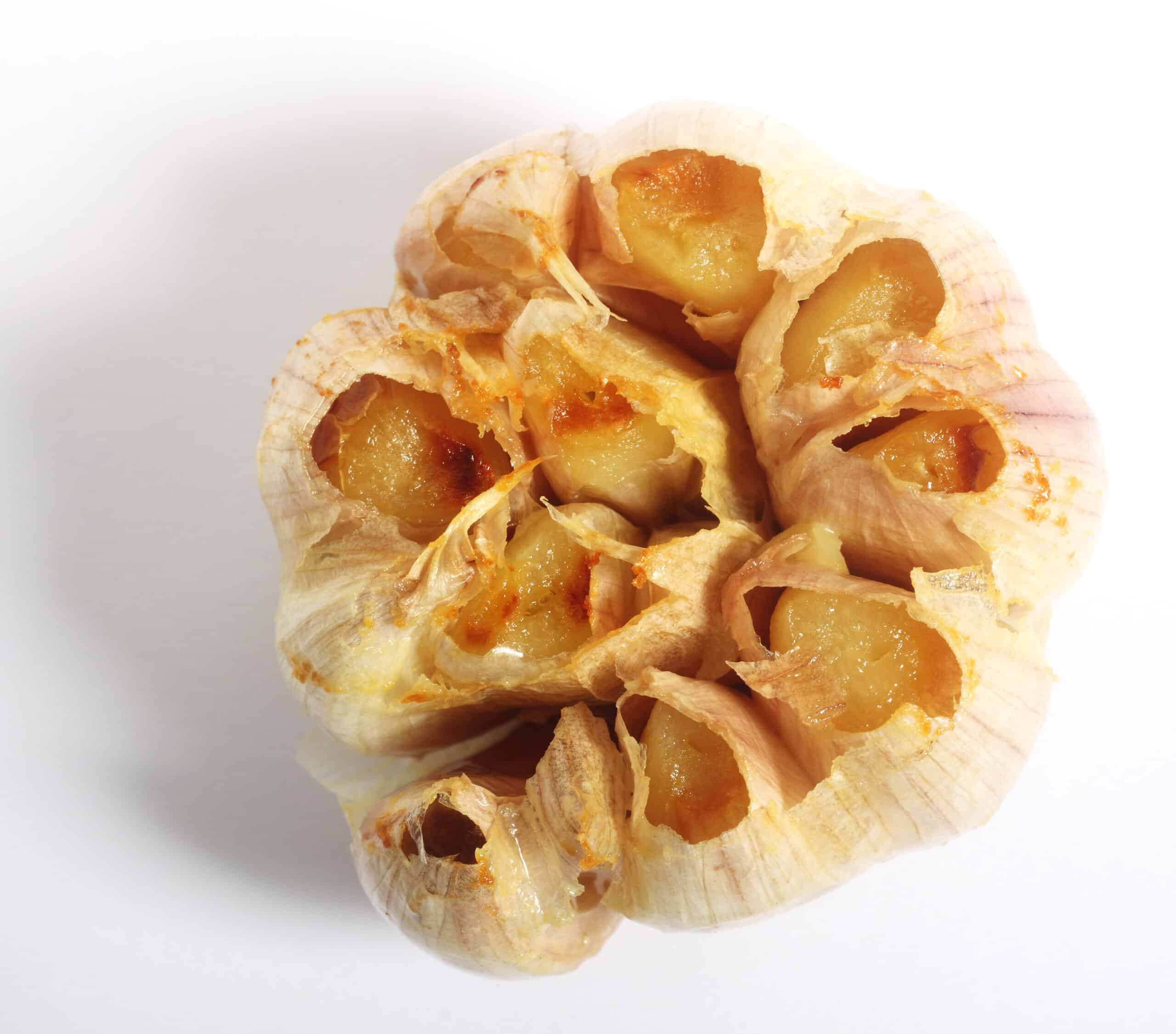
Garlic flavor
- A whole garlic clove sautéed in oil will have a sweet, delicate flavor.
- A whole garlic clove cooked slowly will have a mellow, nutty flavor.
- Cut garlic—raw or cooked—will be pungent and hot.
- Minced or crushed raw garlic will be the most boldly potent of all.

Garlic serving suggestions
- Garlic is widely used in soups, sauces, salads, stews, braised dishes, sautés, and as a seasoning for meats, fish, poultry, and game.
- Garlic goes well with almost any savory food: basil, broccoli, chicken, crab, mushrooms, potato, shrimp, spinach, steak, tomatoes, and tomato sauces to name a few.
- Garlic is most commonly used as a condiment or seasoning. Garlic can be used as a flavoring agent in vinaigrettes, soups, vegetables, tofu, meats, stews, cold meats, and marinades.
- Use raw or chopped garlic in aioli sauce, rouille, pesto, and garlic butter.
- Garlic can be added to butter, cheese spreads, bread, beans, broccoli, cauliflower, crackers, stuffings, herb vinegar, flavored oils, and pickles.
- Rub skinned whole, raw garlic on bread or around the sides of a salad bowl.
- Use chopped or crushed raw garlic as a seasoning for raw vegetables, in pesto sauce, garlic butter, or garlic purée.
- Press raw garlic to get aromatized garlic oil.
- Cook whole garlic cloves in ragoûts and braised dishes and in roasts and soups.
- Use peeled cloves, sliced or chopped in sautéed dishes.
- The green stems of fresh garlic may be used in place of shallots or chives.
Garlic cooking suggestions
- Sauté: To use garlic as a base for savory dishes, sauté peeled cloves briefly just before adding the other ingredients. Sautéing–or “sweating”–garlic just before mixing it with other foods will soften its texture and mellow its flavor. Do not allow garlic to brown when sautéing; this will destroy the flavor and can make food taste bitter.
- Roast: Roasted, poached, double-poached, or glazed garlic can be served as a vegetable. Here’s one simple way: roast unpeeled garlic whole for 15 minutes at 350°F then serve as an accompaniment to roast meats or poultry.
More Cooking Tips
- For the maximum flavor of garlic, add it at the end of cooking—in the last 20 or 30 seconds.
- For a more subtle flavor, cook garlic whole without peeling or cutting.
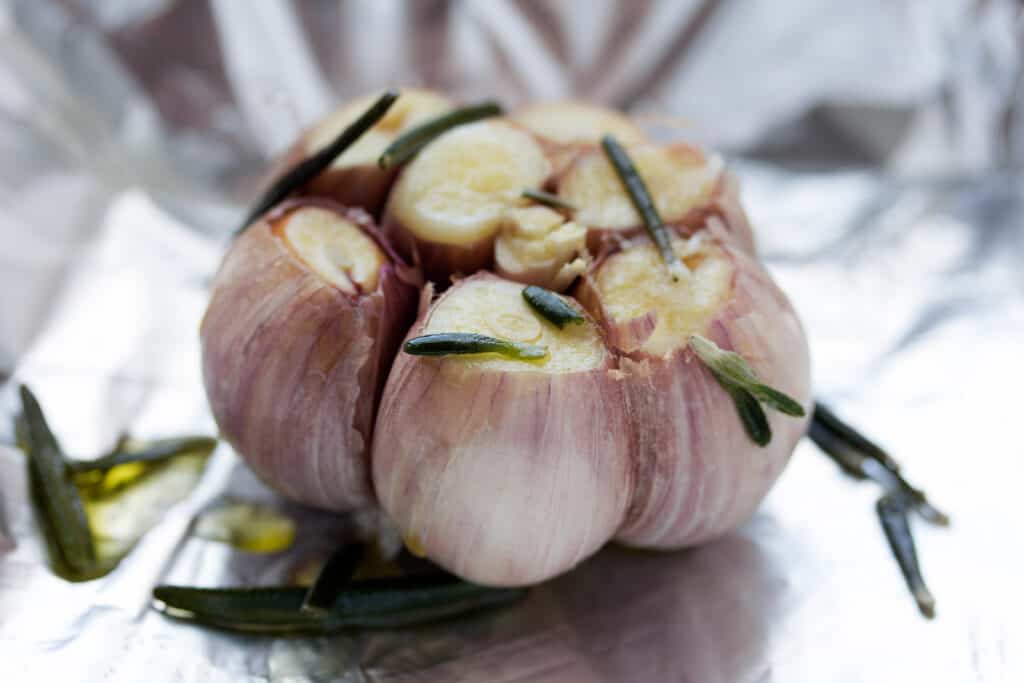
How to roast garlic
- Preheat the oven of 375 degrees F. Place a rack in the middle of the oven.
- Peel away as much of the paper surrounding the garlic head as possible leaving the cloves connected.
- Use a sharp serrated knife to trim the top of the head away leave the tops of the cloves exposed.
- Lightly drizzle olive oil onto the tops of the exposed cloves and sprinkle with salt.
- Wrap the head in aluminum foil, place head on the heated rack, and roast for 40 minutes.
- Garlic is finished cooking when the center clove can be pierced with the sharp end of a knife.
- For caramelized flavor, continue roasting until the garlic is golden brown. Check often to not overcook.
- Cool the cloves and serve. Serve by pressing on the bottom of a clove to push it out of its paper.
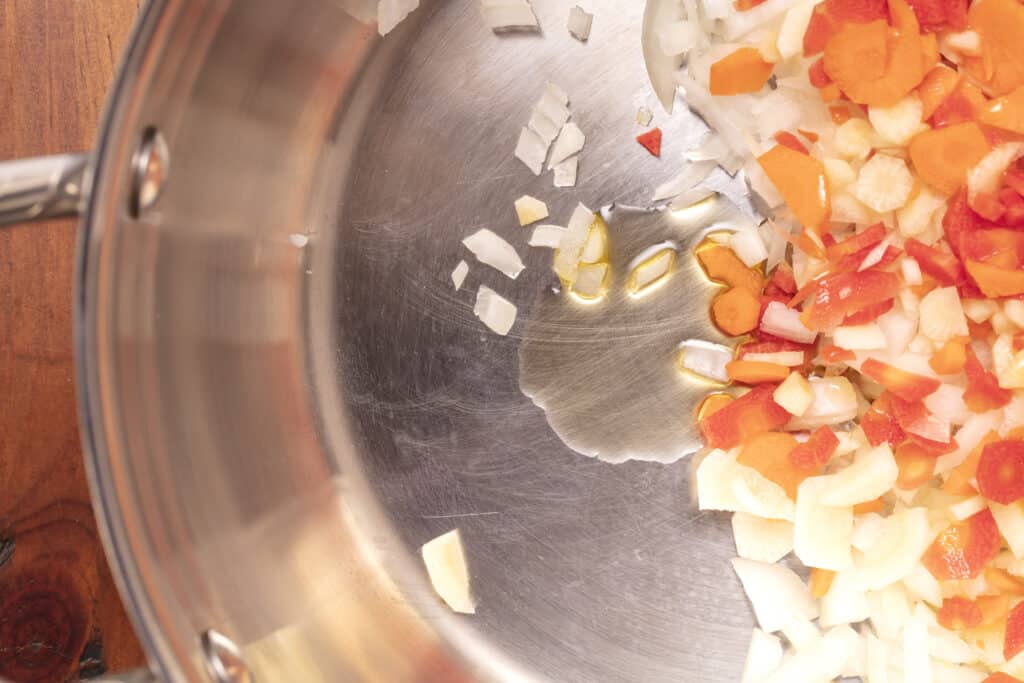
How to sauté garlic
Sauté garlic to season a savory dish, sauce, or dressing.
-
Separate and pre-peel individual garlic cloves.
- Chop or slice the cloves.
- Place butter or olive oil in a small skillet over medium-low heat.
- When the butter or oil is hot, add the garlic and cook stirring frequently until it softens; do not brown or overcook the garlic.
How to braise garlic
- Separate and pre-peel individual garlic cloves.
- Put a half cup of olive oil in a small skillet over medium-low heat.
- When the soil is hot, add the garlic and sprinkle with salt.
- Adjust the heat so that the garlic just sizzles.
- Cook until the garlic is evenly golden and just begins to brown.
- Use immediately or store in the refrigerator in the oil for a day or two.
How to make garlic butter
- Chop or mince 4 large cloves of garlic (use raw or sauteed cloves) very fine.
- Melt 6 tablespoons of butter in a small saucepan over low heat.
- Add the garlic and cook until it softens.
- Let the butter and garlic cool add more butter at room temperature and whip.
- Add salt, freshly ground pepper, and lemon juice to taste.
Use garlic butter to brush or base broiled or grilled fish, chicken or meat or on baked potatoes or rice or noodles.

How to choose garlic
- Select garlic cloves that are plump, firm, and free of sprouts (green sprouts are indigestible).
- The skin should be dry, even flaky, and intact.
- Avoid cloves that are soft or shriveled. The size of a garlic clove will not affect its flavor or freshness.
How to store garlic
- Keep garlic heads in a cool, dry, well-ventilated place.
- Garlic will keep for up to 8 weeks if kept at room temperature, after that the heads may begin to dry out.
- Once garlic heads are broken, the individual cloves will keep for about 3 to 10 days.
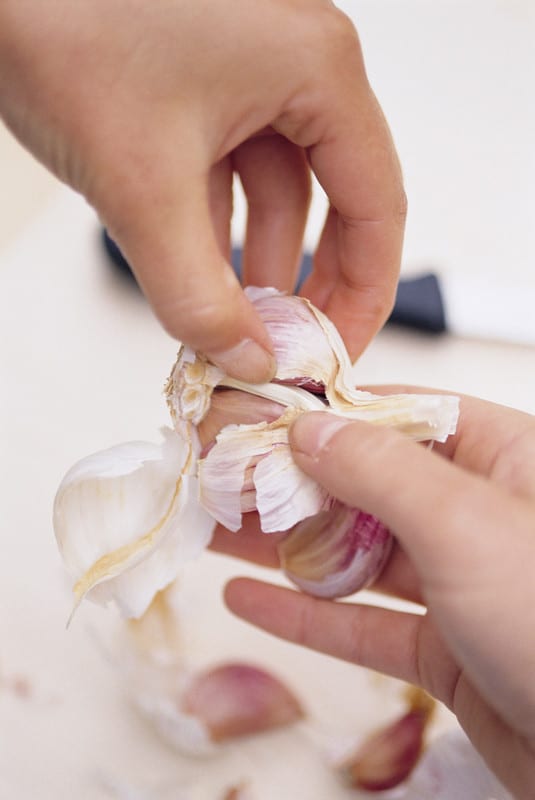
How to prepare garlic for cooking or use raw
- The flavor of garlic is released only when it is cut, crushed, or chopped—the more finely chopped or crushed the stronger the flavor.
- Place the bulb upside down and press down hard on the head with the palm of your hand or roll the head back and forth on a counter. The cloves will break free.
- Cut off the tip from each end of the clove and peel off the flaky skin. Individual cloves can be peeled more easily if they are first crushed slightly with the side of a knife blade.
- To remove the skins without crushing the cloves, microwave the head of garlic for 1 minute on high power, turning halfway through cooking. The skins will then slip off.
- Crushing chopping, pressing or puréeing intensifies the flavor of garlic. Heating garlic will mellow its flavor.
- Garlic is odorless until its skin is peeled away. When the skin is peeled away or broken enzymes activated by the exposure to air start to work on the garlic flesh producing a compound called allicin. Allicin gives garlic its pungency.
- The more finely you chop garlic the more allicin that is produced and the greater the pungency.
How to deal with garlic breath
- Use parsley, mint leaves, or coffee grounds to freshen your breath after eating garlic.
Garlic nutrition
- Garlic is a very good source of selenium.
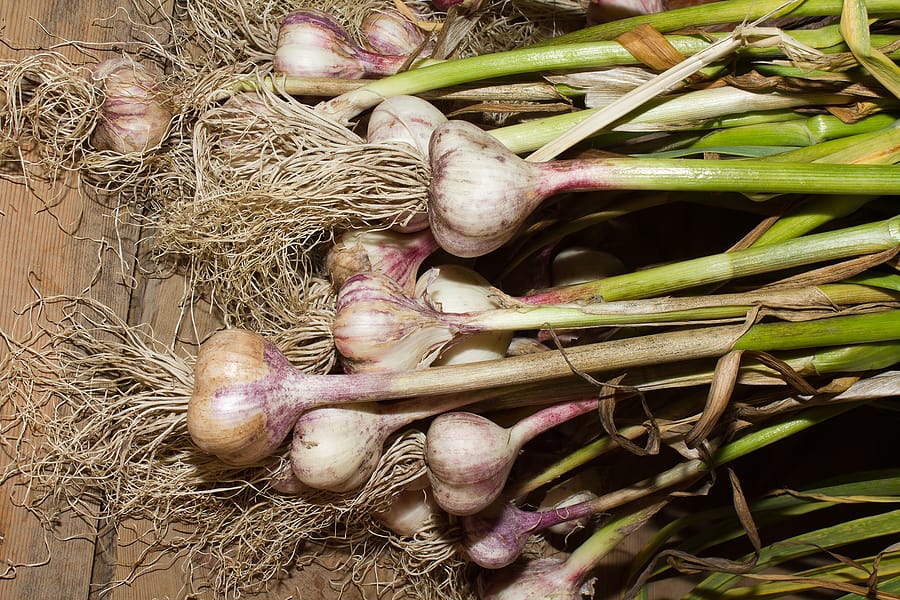
Get to know garlic
- Garlic is an annual herb that grows from 12 to 24 inches (30-60 cm) tall. It has solid, narrow, strap-shaped leaves that grow atop an underground round bulb or head that is enclosed in a white papery sheath.
- Each garlic bulb is made up of a cluster of 12 to 16 bulblets called cloves. Cloves can have white, pink, or violet skin depending on the variety.
- Garlic cloves contain an aromatic and strong-flavored sulfur-containing compound called allicin.
- Garlic comes to harvest in both the spring and summer.
- Mature bulbs are harvested in the summer after the plant’s long green leaves have yellowed and dried. The bulbs are pulled from the ground and dried.
- Garlic is often classified simply by the skin color of the bulbs: white garlic, pink garlic, and purple garlic.
- Green garlic is young garlic pulled from the ground before the bulb begins to form cloves. Green garlic is harvested in the spring and resembles a baby leek. The taste of green garlic has a softer more herb-like flavor than mature garlic.
- Green garlic—sometimes called “fresh heads”—is harvested at the beginning of the growing season in spring. The heads of green garlic are soft, thick, and white. Green garlic is succulent, mild, and even sweet.’
- Raw, dried garlic is pungent and hot.
- Garlic is thought to have originated in the mountains of Central Asia—Kazakhstan, Uzbekistan, and Turkmenistan. From there, it spread both east and west. It is one of the oldest cultivated plants, grown for more than 5,000 years in many countries.
- The name garlic comes from the Old English word gar meaning spear, referring to the spear-like shape of the leaves, and leac from the vegetable leek.
- There are several hundred named varieties of garlic, but just two basic types: hardneck garlic (Allium sativum var. ophioscorodon) and softneck garlic (A. sativum var. sativum). Hardneck is the strongest-flavored.
- Garlic is an indispensable ingredient in many of the world’s greatest cuisines including France, China, Mexico, Italy, and Southeast Asia.
- Garlic is perhaps most closely associated with French cooking and is the dominant seasoning in many dishes originating in Provençe—which might be described as the quintessential Mediterranean cuisine.
The botanical name for garlic is Allium sativum.
Garlic articles at Harvest to Table:
How to Harvest and Store Garlic
Five Ways to Cook and Serve Garlic
Oyster Mushroom Sauteed in Garlic
Articles of interest:
Best Herbs for Container Growing
Garden Planning Books at Amazon:
- Vegetable Garden Almanac & Planner
- Kitchen Garden Grower’s Guide Vegetable Encyclopedia
- Vegetable Garden Grower’s Guide
- Tomato Grower’s Answer Book
More kitchen tips:
Bring your harvest to the table. Kitchen prep tips and easy recipes for the vegetables you grow. Click below for vegetable prep and recipes you can use now.
- Almonds
- Apples
- Apricot
- Aprium
- Artichoke
- Arugula
- Asparagus
- Avocado
- Bamboo Shoots
- Banana
- Basil
- Beans, Dried
- Beans. Long
- Beans, Shell
- Beans, Snap
- Beets
- Bitter Melon
- Blackberry
- Bok Choy
- Broccoli
- Broccoli Raab
- Brussels Sprouts
- Cabbage
- Cardoon
- Carrots
- Cauliflower
- Celeriac
- Celery
- Chard
- Chayote Squash
- Cherimoya
- Cherries
- Chestnut
- Chickpea
- Chinese Cabbage
- Chives
- Cilantro
- Citron
- Clementine
- Collards
- Coriander
- Corn, Sweet
- Corn, Baby
- Corn Salad, Mache
- Cranberry
- Cress
- Cucumber
- Daikon
- Dandelion
- Dill
- Eggplant
- Endive, Belgian
- Endive and Escarole
- Fava Beans
- Fig
- Florence Fennel
- Garlic
- Ginger
- Grapefruit
- Grapes
- Guava
- Horseradish
- Jerusalem Artichoke
- Jicama
- Jujube
- Kale
- Kiwifruit
- Kohlrabi
- Kumquat
- Leeks
- Lemongrass
- Lemons
- Lettuce
- Lime
- Mache (Corn Salad)
- Mandarin Orange
- Mango
- Maple Syrup
- Marjoram
- Melons
- Michihili
- Mint
- Mizuna
- Mushrooms
- Mushrooms, Cremini
- Mustard Greens
- Napa Cabbage
- Nectarine
- Okra
- Olives
- Olive oil
- Onions
- Oranges
- Oregano
- Parsley
- Parsley Root
- Parsnips
- Passion Fruit
- Pawpaw
- Peaches
- Pears
- Peas, Garden Snap
- Peas, Snow
- Pei Tsai
- Peppers, Chili
- Peppers, Sweet
- Persimmon
- Pineapple
- Pineapple Guava
- Plantain
- Plums
- Pluots
- Pomegranate
- Potatoes
- Prickly Pear
- Pumpkin
- Quince
- Radicchio
- Radishes
- Raspberries
- Rosemary
- Rhubarb
- Rutabaga
- Sage
- Salsify
- Sauerkraut
- Savory
- Shallots
- Sorrel
- Spinach
- Squash, Summer
- Squash, Winter
- Strawberries
- Sunchokes
- Sunflower
- Sweet Potato
- Swiss Chard
- Tangerine
- Taro
- Tarragon
- Thyme
- Tomatillo
- Tomato
- Turnip
- Turnip Greens
- Yams



